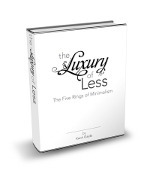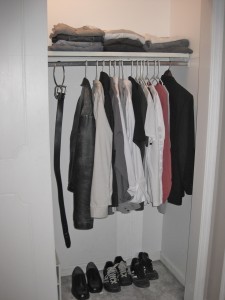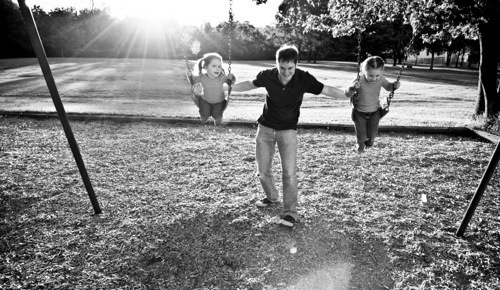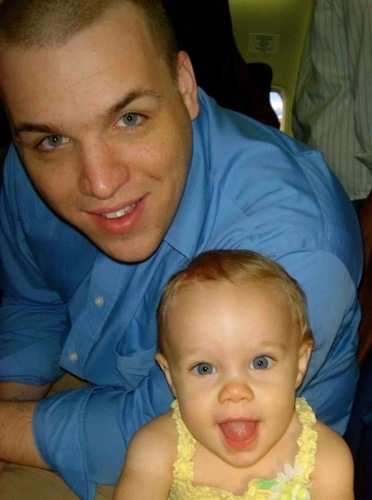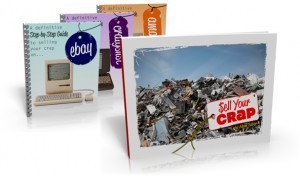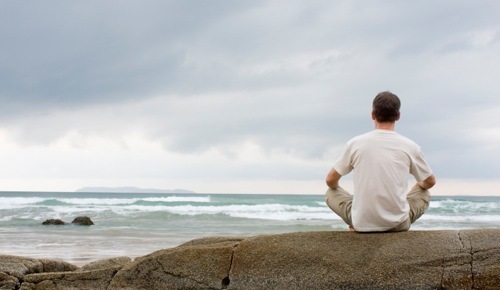Joshua Becker's Blog, page 154
October 4, 2010
3-Day Minimalist Book Sale
For the next 72 hours,, the 3-Day Minimalist Book Sale will be live.
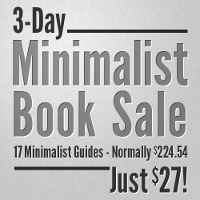 WHAT IS THE MINIMALIST BOOK SALE?
WHAT IS THE MINIMALIST BOOK SALE?For the next three days (Monday at 10am EST – Thursday at 10am EST), 13 minimalist authors have come together to offer 17 courses/e-books/guides in one unbelievable package for only $27. If bought separately, the 17 products total a retail value of $224.54. But for the next three days, you can find them all in one location for one low price. If you've been debating the purchase of even one of these products, now seems like the perfect time to jump in.
WHY THE MINIMALIST BOOK SALE?
A few months ago, Karol Gajda contacted a number of bloggers via e-mail asking them to come together for one giant event. Karol is releasing a new e-book today titled The Luxury of Less in which practical advice offers insight into the "five rings" of minimalism (health, wealth, relationships, experiences, void). To help with the launch, Karol wanted to do something big. He wanted to offer something that has never been offered before. And the 3-Day Minimalist Book Sale was born.
Personally, I have decided to contribute for three reasons:
It's good publicity. (And I always welcome new publicity).
It makes me proud to be part of something this big.
It's a good opportunity to get Simplify into peoples' hands. My hope when writing the e-book was to inspire people to declutter their home and life. To date, it has been read thousands of time by thousands of people. Hopefully, through the 3-Day Minimalist Book Sale, it will inspire a thousand more.
WHERE CAN I BUY THE BOOKS?
The deal can be found by clicking right here. Note: You will be redirected to the sale page on Karol's website.
WHAT BOOKS ARE FOR SALE?
I'm glad you asked. Here you go:
1) Leo Babauta's The Simple Guide To A Minimalist Life. Regular price: $9.95. The leading blogger on the planet offers the leading book on minimalism. In classic Leo-style, he offers useful chapters on different problems that people will face on their journey to a more minimalist life.
2) Adam Baker's Unautomate Your Finances: A Simple, Passionate Approach To Money. Regular Price: $17.00. A comprehensive approach to help you get back in control of your finances, rather than the other way around. Adam has found internet stardom by sharing his own story of getting out of debt and helping others do the same.
3) Everett Bogue's The Art of Being Minimalist. Regular Price $17.00. Everett embraced minimalism so that he could quit his 9-5 job in order to live and work from anywhere. In his first e-book, he writes about his journey and the lessons learned to help his readers accomplish the same. On a personal side note, this is the work that inspired me to write Simplify.
4) Tammy Strobel's Smalltopia: A Practical Guide To Working For Yourself. Regular Price: $27.00. Tammy's newest ebook (released August 31) centers around her goal of equipping others to work for themselves. Having made the decision herself, she knows firsthand what it takes to make the step. But that doesn't stop her from getting contributions from 14 other bloggers who have made the same decision.
5) Tammy Strobel's Simply Car-free: How To Pedal Toward Financial Freedom and a Healthier Life. Regular Price: $9.95. If you've ever thought about ditching your car and saving $5,000-7,000/year, this e-book may be the only extra motivation you need. Living in Portland, Tammy and Logan made the decision to ditch their vehicles years ago… and have never looked back.
6) Joshua Becker's Simplify: 7 Guiding Principles to Help Anyone Declutter Their Home and Life. Regular Price: $9.95. A thought-provoking, enjoyable read to help you begin enjoying a simple new life. I share the 7 most important lessons that we learned during our journey towards minimalism to help others do the same.
7) Charley Forness's You, Simplified Handbook. Regular Price: $5.00. Charley's wrote this book based on his personal experience. It is short and sweet, with real down to earth strategies. There is no fluff, there is no sugar coating, there is just what Charley did to successfully simplify his life.
8) David Damron's Simple. Minimalist. Life. Version 2.0 Deluxe Edition. Regular Price: $27.00. David's goal with the Simple. Minimalist. Life. (and subsequent e-books) is to help you not just clean out the closet, but free you from the constraints of chaos.
9) David Damron's Project M-31: Simplify Your Life In 31 Days. Regular Price: $15.
10) David Damron's Minimalism: 7 Steps To A Simpler Life. Regular Price: $4.95.
11) David Damron's Simple Health & Fitness. Regular Price: $9.95.
12) Annie Brewer's The Minimalist Cleaning Method. Regular Price: $9.95. Annie details proven techniques to make house cleaning easier, faster, and even cheaper by getting more work/progress done with less cleaning supplies than most folks use now.
13) Meg Wolfe's Minimalist Cooking – Take Back Your Kitchen. Regular Price: $4.95. Meg, of the Minimalist Cook, prides herself on kicking the marketer out of the kitchen and letting the cook back in. Her beautifully-illustrated and super-helpful cookbook accomplishes that very goal.
14) Sam Spurlin's Living The Simpler Life. Regular Price: $9.95. Geared toward those beginning their minimalist journey, Sam breaks down living a minimalist life into 8 key practices and gives the reader tools and ideas to apply each practice.
15) Brett Oblack's Consume Less, Create More. Regular Price: $9.95. Brett offers thoughts and tips on how to embrace minimalism and how to channel all of that extra minimalist freedom into creating art you are proud to call your own.
16) Henri Junttila's Passionate Living Guide. Regular Price: $27.00. A full-blown course that'll take you by the hand, and point you in the right direction to help you pursue your passion by doing what you love.
17) Karol Gajda's The Luxury of Less Special Edition. Regular Price: $9.99. Karol's brand new e-book (discussed above) will be available in PDF format for these three days only. After the 3-Day Minimalist Book Sale is complete, it will only be available via Kindle and Print Form. So get it now by purchasing the bundle.
If any of the preceding minimalist books peaks your interest, you can purchase them individually by clicking through above. Or, you can purchase them all for $27. Not a bad deal if you ask me.


October 1, 2010
Why I Don't Count My Stuff (and Why I Am Excited to Start).
Why I Don't Count My Possessions
As I wrote in an earlier post (The 7 Most Influential Posts During my Early Journey to Minimalism), Dave Bruno has been an inspiration to me. Dave is generally considered the man behind the (or at least, he got to write the book) which has gained much popularity among minimalists. Leo Babauta, and Tammy Strobel represent just two who have taken the challenge. The goal of the challenge is to pare your possessions down to only 100 things.
If you have followed this blog for any length of time, you know that I have never counted my possessions. Not only have I never counted them, I've never had a desire to count them. And while I commend the numerous minimalists and bloggers who have pared their possessions down to less than 100 things, I am not one of them. Here are some of the reasons why:
I own well more than 100 things. My brand of minimalism will also require that I do. For example: I live in the suburbs. I own a home. I do not live near public transportation. I love to entertain. And my job requires a certain level of possessions.
Living with 100 things has never sounded attractive to me. I love minimalism. I love the freedom of paring down my possessions and focusing on what's most important in my life. And I have found more and more freedom by removing more and more belongings. But at some point, it no longer sounds attractive to me. And that number is somewhere higher than 100 things.
My minimalism has always been rational, not rigid. Arbitrary numbers have never guided by practice of minimalism. Instead, I have tried to allow my life to be guided by the things that are most important to me.
Counting seems like it would take a lot of time. And that's why I started getting rid of stuff in the first place.
And finally, I'm far too competitive to ever give it a shot. I mean, let's face it, Colin Wright owns 55 things and Everett Bogue lives with 57. At this point, there is nothing impressive about listing 167 or 142 or even 112.
Why I Am Going to Start Counting
With that being said, I am thrilled to participate in Project 333 inspired by Courtney Carver at Be More With Less. Project 333 represents a growing number of participants who have decided to wear only 33 items of clothing for the next 3 months (October 1 – December 31). You can read more of the rules here. I first heard about the challenge through Robyn Devine and couldn't wait to jump in.
Here are the reasons why I have decided to join Project 333… and start counting:
It sounded reasonable, but challenging. I've always needed a certain number of clothes working in an office 5 days/week, speaking to large groups of people, being an active part of the community, exercising daily, and maintaining the yard. 33 items to accomplish all those responsibilities sounded just about right… yet, still a stretch.
I needed the extra push. Project 333 will provide extra incentive to push my limits – which is the point. I have sat somewhat content in my minimalist journey for awhile now. This project will hopefully push me to a new edge. And teach me new things about myself.
The community is exciting. Knowing that I am just one of a large number or participants provides extra motivation. I haven't heard the final number of participants, but it's extra fun knowing that there is a group of people around the world jumping in too. And they appear to be very active on the Facebook page.
It sounds fun. I'm in. Two years ago, getting to pick out 33 new items at a clothing store would have sounded fun. Today, limiting myself to 33 sounds fun… Oh, how my life has changed.
My 33 Items.
Here then is my list of 33 items (most are pictured above):
(4) Black Suit – Pants, Jacket, Belt, Tie (to wear once while I perform a wedding)
(4) Yard Work Clothes – Jeans, T-Shirt, Sweatshirt, Boots (mowing, raking, shoveling)
(3) Jeans
(1) Khaki Pants
(3) V-Neck T-Shirts
(3) Button-Down Shirts
(1) Short-Sleeve Button-Down Shirt
(3) Long-Sleeve Casual
(2) Sweaters
(1) Sweatshirt
(3) Shoes (black dress, black casual, sneakers)
(1) Black Belt
(1) Silver Wristwatch
(2) Coats (khaki jacket, black leather)
(1) Gloves -not pictured.
A Few Notes.
I feel that being a male gives me a little advantage in the challenge. I have far less accessories than many of the women in the challenge. However, needing to count the suit (4 one-time items and 1 button down shirt that I wouldn't have normally picked) and the 4 outdoor chore items seems to help level the playing field.
You'll notice from the photo above that I am basically wearing white, black, and gray for the 3 months. I removed a few blues for the sake of not needing to carry brown belts or shoes. I typically enjoy wearing those neutral colors anyway, so it was not a difficult decision.
I have set aside one pair of jeans and button-down shirt for some public speaking coming up (VT, VT, AZ, and now MN). Too alleviate my fear of wearing out those items, I have set them aside exclusively for the speaking engagements.
I did not include my heavy winter coat in my 33 items… here's hoping for a mild December in Vermont.
It is never too late to join the Challenge. Perhaps you want to give it a shot. Or perhaps I will enjoy the exercise so much, the next number I will count to is 100… you just never know for sure until you try it.


September 29, 2010
How to Simplify Your Stuff and Honor Your Memories
Editor's Note: This is a guest post from Courtney Carver of Be More with Less. It is also an answer to one of your Frequently Asked Questions .
"I have memories – but only a fool stores his past in the future." – David Gerrold
As you simplify, you will notice that the most important stuff is left. This applies to kitchenware, toy boxes, closets and even to your sentimental treasures. Often times, the most difficult stuff to get rid of, is the stuff soaked in memories. We become attached to things that remind us of our past, and our loved ones. Your great grandfather's pocket watch, your first pair of roller skates, or your son's artwork from kindergarten, all transport you to another time, and usually fill you with lovely memories. Unfortunately, because you don't want to clutter your home with stuff, these treasures are buried in boxes in the garage or attic, only to be rediscovered during a move, or a trip down memory lane.
I must admit, I am a sap and a sentimental fool. I get teary driving past a wedding, hearing stories about my grandparents or cooking one of my favorite dishes from childhood. In my life, I have saved notes from the 4th grade, albums from my first rock star crush, my daughter's first bathing suit, heart shaped rocks from hiking with my husband and jackets my dad gave me that never fit, but were so cool, because they were his.
How do you get rid of the stuff that means so much, and evokes so much emotion, in the name of minimalism and simplicity? There are several ways to simplify the sentimental. Each concept includes focusing on what is most important and honoring your history.
Share the love. Unless you are on a mission to live with less than a certain number of things, why not display some of your sentimental items? Less does not mean none. Paring down your objects of memory does not necessarily mean ridding yourself of them all. Instead, paring down your sentimental items allows you to focus on the most meaningful. Chances are, the things with all the memories are in a box in the garage or attic. Sort through those boxes and choose the things that mean most to you and your family and display them. Sometimes we hold onto things to hold onto people that have left our lives. Honor the ones you love by sharing what was theirs.
After all, a box full of memories stashed in the basement is far less meaningful than 3-4 specific items displayed proudly in your home. So go through that box of mother's things in the basement, select the 3 that most represented her life and the influence that she had, display them proudly, and remove the rest.
Make it useful. Did you save the china that your parents received on their wedding day or a special necklace that was passed down to you? Why not use it? Donate your everyday plates and eat off the dishes that mean so much. Wear the memorable piece of jewelry every day instead of waiting for a special occasion, or forgetting about it completely. You may come across things that you can't use and don't want to keep, but someone else will find your sentimental items to be quite useful. Use them or pass them on.
Put it in the cloud. If you have been saving printed photographs, documents, receipts and other paperwork for years, it might be time to digitize your docs. Sort through it all and toss the trash. Scan the rest or hire someone to do it for you, and organize in folders. From there, back it up through Dropbox.
Shoot your stuff. When you are uncluttering, save the things that mean the most to you, and take a picture before letting them go. Preserve the memories inspired by stuff through photography. Group items creatively or take pictures using the things. For instance, if you saved a baseball hat from your childhood little league team, take a picture of your child wearing it. Create a digital photo book with images and descriptive text, so you can enjoy your memories without the clutter. A book like this makes a beautiful gift to someone else in the family who wants to enjoy the memories without the clutter.
Tell your story. The most powerful thing we can offer is our story. As you simplify your life, you will come to the realization that the most sentimental things aren't things at all, but stories of the people and places we love, and how we spend our time. Write about the things you love, instead of holding onto them. Start a family blog or keep a personal journal. Your words may start out describing your mother's watch, but turn into a beautiful story about an afternoon the two of you spent together.
Approach each area or section of your life the same when it comes to letting go, and revel in what unfolds. Not only do you make room for the good stuff, but you can clearly identify what is most meaningful to you. Instead of filling boxes with the things that define your life, spend more time creating your life, giving to others and sharing your story with actions, thoughts and gratitude.
What other ideas do you have for shedding sentimental stuff?
***
Courtney is a writer and fine art photographer. She writes about simplifying and living life on purpose at Be More with Less. You can also follow her on Twitter.


September 27, 2010
Adam Baker on the Importance of Selling Your Crap
Last week, Adam Baker of Man vs. Debt released an awesome new guide appropriately titled Sell Your Crap. And as far as e-products go, it completely blew me away. I'm not sure exactly what I was expecting when I sat down to read it… but I was pleasantly surprised at the comprehensive nature of the books.
For example, Sell Your Crap doesn't just tell us how to get rid of our stuff, it also introduces the concept of minimalism in a clear and compelling way. It succinctly lays out the reasons why we collect so much clutter in our homes, its negative impact on our life, and the rationale arguments to remove it. It helps the reader define the difference between crap (things to remove) and stuff (things to keep). It compels the reader to sell his/her crap and then helps them through the actual selling process beginning to end.
I sent an e-mail to tell him how impressed I was at the guide and how appropriate it would be for so many Becoming Minimalist readers who are just starting out on their journey. I threw in a few interview questions to help him introduce the guide and his story. I hope they offer you an insight into his thinking, a preview into the guide, and extra motivation to "sell your crap."
1) For Becoming Minimalist readers who are not familiar with your story, can you tell it in less than 4 sentences?
In 2008, we were on the typical life path – piles of stuff, dozens of loans, married, pregnant, and in new careers. The birth of our daughter, Milligan, finally helped us gain the clarity to see that the way we were currently living our life did not match up with the way we really wanted to live our life. We made the decision – right then and there – that we would take the next year to sell everything we owned, pay off our consumer debt, and move overseas to Australia. Over the next 10 months, we slowly, but surely sold and donated everything that didn't fit in our two backpacks, paid off $18,000 in debt, and spent the next year traveling through Australia, New Zealand, and Thailand.
Man, that was fairly hard to do in 4 sentences! Wait, do these count against me? Oh no!
2) Thanks. Now, tell us why you decided to write the Sell Your Crap Guide and what you are hoping to accomplish with it?
The Sell Your Crap guides were actually born out of what I saw as a need. The more we began to share our story with people, the more questions they began to ask about how we were able to sell everything we owned and live out of our backpacks for a year (especially with a 1-year-old). After fielding hundreds of the same questions about the process, I realized that sharing our story wasn't enough! People really needed a comprehensive, step-by-step guide to helping them attack and purge their crap and clutter. So I wrote it!
In short, I'm trying to accomplish two main goals. First, I want to help people let go of all the tangible crap in their lives that is holding them back. Courtney and I didn't realize it at first how much our stuff (and our pursuit of stuff) was muzzling our freedom in life. It was weighing us down more than we even knew. Once we ditched it, we were so much more free to spend our time, energy, and money on the things we were truly passionate about. I really want to show others how much their excess stuff weighs them down and then help them purge it from their lives!
The second goal is to help teach people the practical tips and strategies to get much more money for their items in a fraction of the time it would normally take. This involves teaching people how to leverage platforms like eBay, craigslist, and Amazon to maximize the amount of cash they put into their pockets. It's all the tactics Courtney and I wished we would have known starting out, but that we learned the hard way through a year of selling and studying. I've found that if you focus on saving time, much more people (we are all so freakin' busy!) are able to finally start making progress on their clutter. So that's a big priority and goal for the guides, especially the individual modules.
3) As I mentioned earlier, I am so impressed at how comprehensive the Sell Your Crap Guide is from beginning to end (from identifying our clutter/crap…determining why it's in our home… counting its true cost… and helping the reader formulate a step-by-step strategy to remove it). It covers the entire journey from beginning to end. Is there a section of the guide that you are particularly proud of more than the others? Why?
Yikes, that's a tough question. I'm not sure, I'm more proud of one section or another, but if I had to pick a single section… I'd say the eBay Module. My goal for the eBay Module was for it to be around 10,000 words and maybe a couple dozen screenshots. As I started digging into writing, taking screenshots, and breaking down the best practices step-by-step… it ballooned. I kept finding tactics and tips I could add to help squeeze out value. It ended up growing to over 35,000 words and 65+ screenshots. Frankly, I think it may be the single most valuable (at least in direct value) content I've ever written. I'm very proud of it.
4) Based on your research, what is the most common mistake that people m ake when selling their crap?
By far, the most common mistake is not actually selling it at all. We make all sorts of excuses why we may need an item, why it may not be worth anything, and why we have sentimental attachment to it. People will create and revisit these justifications a dozen times throughout the selling process. When we first touch the item, then when we research it, then when we start to create the listing… we revisit all these excuses over and over again. It's mentally exhausting and makes the process take an insane amount of time.
The best way to combat this is to make a decision up front that you no longer need the item in your life. Instead of thinking what you can sell… think what needs to sell. Once you make the decision that something is no longer needed… DO NOT revisit it. Mentally and emotionally part ways with the item first. Then, and only then, research the item and purge it in the best way possible.
This small but important distinction saves hours and hours of time and an enormous amount of mental stress. It'll get you into action and selling!
5) Your guarantee is one of the most unique that I have ever seen on an e-book. Tell us about it and where the idea came from.
Well first, the guarantee is a $100 Effectiveness Guarantee. Everything I do is always no-questions-asked, 100% refundable if it isn't valuable. But I wanted to do something more tangible this time. So for Sell Your Crap I decided to go with this $100 Effectiveness version.
In short, if you don't sell at least $100 worth of your excess and useless clutter, simply email me for a refund. In reality, you'll save far more than that in time and energy, but I wanted to ensure that these guides got you into action and put $100 directly into your pockets. If not, I'll refund the full amount. As always, no questions asked and no special hoops. I'm super passionate about this product and convinced it'll help kick your butt into gear. So I decided to guarantee it in that way!
To give full credit where credit is due, I stole the concept for the guarantee from Chris Guillebeau. He is always pushing me (and others) to guarantee not only satisfaction, but effectiveness. I was inspired by his own creative, tangible guarantees for his own remarkable products!
Thanks, Adam for the interview and for furthering the hope that is minimalism.
You can read more from Adam at his blog, Man vs. Debt, follow him on Twitter, or pick up Sell Your Crap for as little as $37.


September 23, 2010
Enjoying Life in the Slow Lane
Editor's Note: This is a guest post from Mike Donghia of The Art of Minimalism.
"There is more to life than increasing its speed." - Mohandas K. Gandhi
78.4 years isn't much time. And that's coming from a college student.
Even at my age, I can feel the pressure to pack my life full of activity and maximize my time by doing all I can.
In school, we're encouraged to join as many clubs as possible to make the most of our educational experience. At work, it's expected that we'll be uber productive and take on more and more responsibility. Even at home, there's a never ending to-do list of things that need maintained, fixed or upgraded.
And we go on living as if there's nothing wrong with this system. As if the natural progression of humankind is to become the most efficient life form on earth.
If there's nothing wrong with this system, then why are so many people unhappy? Why are so many on medication to control anxiety, stress, and depression?
Isn't this a more telling sign of our "progression" as a species?
All this busyness has overloaded our minds. And we walk around with this nagging sense that there's something we forgot to do. Or we feel guilty when we actually do take time to do nothing, be lazy with some friends, or watch a worm inch its way across the sidewalk.
There's just no rest; no sense of completion. Ever.
And its eating away at us from the inside. Making it impossible to find a reason to smile, or be joyful, or just be.
But life doesn't have to be so crazy. The craziness ends when people embrace the alternative: slowing down.
Slowing down is radical in this day and age. An age where…
…we burn with frustration if a website doesn't load instantly.
…we think taking a nap is a sign of laziness.
…we check our email, facebook, twitter 15 times a day.
…we eat instant oatmeal for breakfast, frozen meals for lunch, and order takeout for dinner.
…we lose sleep over an upcoming deadline.
…we even take our own lives because the pressure to perform is too much to handle.
Breaking these habits can be difficult. But why is that?
We fear that something bad will happen if things don't get done. To calm that fear we work harder, and longer, and harder, and longer only to realize that there's more to do.
It never ends.
If you're tired of the grind, let me suggest you step back and take an honest assessment of what needs to be done. Letting go of the compulsion to do all things can be an awesomely liberating high. Simply choose what's most important, and do that. Even simpler, choose to do the things you are passionate about, and drop the rest.
If life in the slow lane appeals to you, here are some easy steps to escape the rat race and enjoy a slower, simpler, happier life:
Choose 3 things to accomplish each day. I know, you could probably come up with a list of 100 things, but don't. Keeping the list this size will force you to decide what's really important. When you finish the list, the rest of the day is yours to relax. With this approach you'll be completing 21 important tasks a week. If you have more than that, seriously reevaluate your commitments.
Learn to say "no." Stop taking on more responsibility. That's what got you reading this article in the first place. Sure, volunteering is a noble way to spend your time, but stretching yourself too thin can rob you of joy. And the world needs joy more than anything.
Be unproductive. Even if you can only manage 20 minutes a day at first. Don't read anything to further your career or impress your friends. Do something useless like skipping rocks across a pond. Or making mud pies with your kids. Or climbing a tree. Dig back into your memory bank, because most of this stuff is stuff you probably did as a kid.
Only check your email twice a day. That includes twitter, facebook, stocks, sports scores, blog stats – anything. Checking these sites can become an addictive habit which steals time you could spend doing stuff that actually makes you happy.
Embrace quality over quantity. Instead of joining every organization, subscribing to every blog, or taking every opportunity you get – try doing fewer things, but choosing the ones that really add value to your life. Pick 3 or 4 blogs and follow them closely. Choose one organization making a difference, and support them. Embracing quality over quantity will make your life less stressful and your experiences more satisfying.
Find a hobby. Try something new, you don't have to be good at it. As long as it excites you and taps into your creativity. Try these: yoga, rock climbing, running, wood work, surfing, reading, blogging, gardening, chess, painting, making music.
Spend time with people you love. This is it, the one piece of advice I'd give you if I could only give you one. Relationships form the backbone of a purposeful life. Sharing secrets, fears, and hopes with another human is the surest way to slow down and enjoy life. Without close contact with other people, we grow into cold, lonely beings. Make time every single day to spend with loved ones, and you won't end up with a single death-bed regret.
***
Mike Donghia writes at The Art of Minimalism. You can check out his site or might I suggest subscribing to his rss feed. You can also follow him on Twitter.
September 20, 2010
Why Prayer Matters… even if God doesn't
"Prayer does not change God, but it changes him who prays." - Søren Kierkegaard
Most people go through life having no clear sense of their true values. Instead, their desires are molded by the culture and the advertisements that bombard them each day from television, radio, magazines, and celebrities. As a result, they find no consistency in life. No unity. Their desires change as fast as the culture and they are quickly swept off their feet by the newest fashion, the most recent technology, or the latest diet fad.
In contrast, a firm conviction of your heart's values leads to a single life. It is not tossed about by the culture. Instead, it is built on the things that you hold truest to your heart. And no new advertising campaign is able to shake it.
The simple life is found there – in the values you hold dearest. And that is why prayer matters.
Prayer slows our mind, calms our spirit, and centers our heart. It removes our mind from the culture of consumption that surrounds us and centers us on something greater and more important. It calls us to identify our desires and articulate our values.
It offers all the benefits of solitude with one added dimension: "the ask." In prayer, we ask for the most important things – the most valuable. In prayer, our mind races to our deepest heart values. Consider the fact that rarely, in prayer, do we ask for bigger cars, nicer houses, or a larger wardrobe. Instead, we think of our families, our friends, our health, our significance, and our greatest ambitions.
And that is why prayer matters… even if God doesn't.
I believe in a God that is cheering for me, helping me, and answering my prayers. For me, prayer is a win-win proposition. It centers my heart and attention on what is most important. It forces my eyes to focus on the invisible rather than the visible. It causes me to remember that true joy is not found in a department store, but is found in relationships with myself, others, and God. And it asks a God who loves answering those requests.
But even for those who do not believe in God, prayer is still a winning proposition. It still centers your heart and attention on what is most important. It still forces your eyes to focus on the invisible rather than the visible. It still causes you to remember that true joy is found in relationships. It still forces "the ask" and focuses your ambition on the most important things.
So find a quiet moment. Find a quiet place. And find a quiet heart. Search it for your greatest desires. And maybe for the first time, make "the ask." Because it matters… even if God doesn't.


September 15, 2010
The 7 Most Influential Posts During My Early Journey to Minimalism
"What we have done for ourselves alone dies with us. What we have done for others and the world remains and is immortal." -Albert Pine
As I have been preparing for Becoming Minimalist's Fall Speaking Tour (if I can consider 4 speaking engagements a "tour"), I have been taking many trips down memory lane. In order to accomplish the task of inspiring others to pursue minimalism/simplicity in their lives, I wanted to remember what my life was like beforehand and what information was helpful for me to hear.
To accomplish that task, I have been reviewing the archives. And it has been interesting to see how my life and blog has evolved over the past 30 months. But more on that in a future post…
As I was reviewing the archives, it occurred to me that I have never given proper credit to the people who spoke into my life during those early weeks and months. So, on a whim, I would like to do that today. Here then, is a list of the 7 Most Influential Posts that I read during my early journey towards minimalism.
Please note: Many of these posts are old. That's the point. There was not much being written about minimalism back then… but what I found was life-changing.
Also note: It is against my template to open links into a new window. However, each of these links do open into a new window – so be warned. The intention is to make it easy to read the post, close the window, and quickly pick up where you left off.
1. How to Become a Minimalist / Nicole LaMarco / eHow. A simple Google search for "How to Become a Minimalist" led me to this article on eHow. And it will forever stand as my first online introduction to the lifestyle. Looking back, I don't recall the practical steps being all that helpful to my journey. But I do distinctly recall the first paragraph further inspiring me to pursue it.
2. A Guide to Creating a Minimalist Home / Leo Babauta / Zen Habits. Thank you, Leo. You were the second article I read about minimalism and gave me all the framework that I needed to begin the journey. Your steps were practical, yet relaxing. You thoroughly explained the benefits of minimalism and put it completely within my grasp. Because of that, I will always refer to your post as the most important article ever written on the subject.
3. The Story of Stuff / Annie Leonard. I don't recall how I stumbled upon this video one afternoon sitting in my office at work, but I can remember the time of day, my surroundings… even the weather outside… the first time I watched it. It was the section on "consumption" that I watched first and she had me hooked within the first 2 minutes when she said, "We have become a nation of consumers." Suddenly, I began to understand how society has raised us and trained us to become consumers for their own selfish motives. It is a must-watch… but you probably already knew that.
4. Learning to Let Go / Jennifer Skinner / The Very Small Closet. Although her site is no longer active and I don't know how to find her, I will never forget the name of Jennifer Skinner. She was one of the first to comment on this blog. More importantly, her post on letting go of clothes set my journey inward. In her three-part series, she lists three common reasons why people struggle to release clothing (associations, fear, imagination for the future). I identified with most of what she mentioned. And quickly realized that the external belongings in my life represent internal thoughts, motivations, and emotions. It turned me on to seek them out… and eventually became the motivation behind my second e-book: Inside-Out Simplicity.
5. / / . Living with only 100 things has never really appealed to me personally, but Dave's example of accomplishing it has given me motivation each step along the way. A friend of mine passed along the original Time magazine article and I have followed Dave ever since. His story continues to inspire me today.
6. Minimalism Our Way / via Mandi Ehman / Organizing Your Way. I feel bad including a post that I wrote, but let me share the story and you'll understand. Mandi was the first person to approach me about writing a guest post. I accepted her request with no hesitation ("A real live blog was asking me to write…"). At the time, I had no idea how it would change my own path towards minimalism. I began researching her blog and discovered that the narrative she was writing was that "organizing" must be done your way or it will never last. That principle soon became an important piece of my journey towards minimalism and a running theme on this blog. Rational minimalism must be applied to your unique lifestyle and value system… or it will never last.
7. A No-Frills Kitchen Still Cooks / Mark Bittman / The New York Times. Mark Bittman took my greatest obstacle (our kitchen) and made it completely doable. His article in the NYT gave me a simple, comprehensive guide on what to keep and what to remove. I referred to it often during "kitchen week" and have referred to it again and again since then. I have even sent it to friends and relatives as a great place to begin when organizing their own kitchen. Thanks Mark. You made my toughest obstacle easier.
Along those lines, I would be thrilled to hear what posts were most influential in your life. You can share them in the comments below.


September 13, 2010
Becoming Minimalist: Where I'm Speaking and What I'm Saying
This week kicks off a month of speaking engagements across the country. I will be in four different locations over the next four weeks and I wanted to let you know where you can find me.
Here are the details of where I'll be (and what I'll be saying) followed by various random personal thoughts:
World-Wide Web. Tuesday, September 14. Voice America Radio , 11am-12pm EST. My radio interview with Holly Berkley will not be a typical 8-minute segment on "You did what with all your stuff?" Instead, it will be an hour-long question/answer conversation on how minimalism in life can bring simple answers to complicated times and how it can offer new-found happiness and abundance to your life. To find out more or listen along, here's the promo.
Omaha, NE. Tuesday, September 21. Christ Community Church. 7pm. As a part of their Double Your Impact Conference, I will be presenting a seminar based on our first book, Simplify. The seminar will certainly focus on the 7 principles to declutter your home and life. But it will also focus on the many practical ways that minimalism leads to a greater life of impact by freeing us up to pursue our greatest values. If you attend the church, you can register on-line. If you don't attend the church but would like to attend the seminar, send me an e-mail… I'll try to get you in.
Essex, VT. Tuesday, October 12. Essex Mothers of Preschoolers. 8:45am, 6:45pm. For my first opportunity to speak in my own hometown, I'll be speaking to nearly 150 mothers of small children of how to embrace rational minimalism in a world of consumerism. I will be offering mothers practical advice to simplify their homes as well as arguing for the increased importance of it as they seek to intentionally parent their young children. Can't wait!
Phoenix, AZ. Sunday, October 24. Journey Church . 9:00am & 10:30am. As part of a series titled "How to Not Waste Your Life," I'll be arguing against a lifestyle of conspicuous consumption and inviting them to embrace a lifestyle of simplicity and minimalism… for their own sake and for the sake of those around them. If you happen to live in the Phoenix area, I'd love to have you attend.
VARIOUS RANDOM THOUGHTS (SOME RELATED, BUT NOT ALL).
We cotinue to be proof that anyone can embrace minimalism. Two years ago, we were a typical, suburban family with two small children. Our home was full of stuff and our time and energy was consumed by it. One afternoon, after a conversation with my neighbor, we embraced a minimalist lifestyle. And we never looked back. We continue to consider ourselves proof that if this typical family can embrace minimalism, so can you.
Becoming Minimalist continues to be proof that anyone can make a difference and inspire others. Originally, this blog was only an afterthought. My extended family lives thousands of mile away from us. We started this blog (with no blogging, writing, or technological education) simply as a means to keep them updated on our progress. Since that humble beginning, we have had the privilege to inspire thousands (& thousands & thousands) of similar families around the world to pursue a counter-cultural lifestyle of minimalism. This website proves that the Internet has created countless opportunities for anyone to make a difference and inspire others.
I'm thrilled to be speaking at a number of churches in the coming month. I grew up in a church and continue to be involved even today. Churches ought to be championing a minimalist lifestyle that shifts our focus from things to relationships. Personally, I'm glad to see a number of churches embracing this movement and sharing it with others.
The invitation of minimalism is accessible to all. I find my variety of venues intriguing – each opportunity carries a different purpose and a different audience. I believe this is representative of the minimalist movement as it continues to grow in all different segments of the population.
Help others and your blog will grow. In December, 2009, Becoming Minimalist totaled 24,950 views. Last month, Becoming Minimalist totaled 425,855 page views. To put that into perspective, this website has grown over 1600% in the past 8 months alone! This can be attributed to one thing: I shifted my focus. The beginning days (first 18 months) of this blog were dedicated to my personal story. But several months ago, I shifted my focus and began writing articles that were specifically designed to help people. And people started to come, and stop, and read, and subscribe. Quick advice: If you want to grow your blog, write content that helps others.
Becoming Minimalist remains only a hobby to me. I still love my full-time job which gives me enormous opportunity to speak into high school students' lives covering a wide range of topics. I still have no intention of giving that up. You can read more at, "How to Become a Successful Blogger and KEEP Your Day Job."
But apparently, I am available to do some speaking. Public speaking plays into my sweet spot as I have been speaking for a living my entire adult life. I have been speaking publically for over 12 years to audiences of dozens, hundreds, and thousands. If you are interested in contacting me about interviews or speaking, I can be contacted via email or twitter.
I am remembering again why I do this: to inspire others. Maintaining a successful, growing blog can be time-consuming. It calls for early mornings and some late nights. Sometimes I am asked if it is consistent with a simplified life… and sometimes those questions cause me to wonder. But I always return to the purpose of this blog: "Inspire people to live more by owning less." This blog is not designed for me to make money or quit my job. It is designed to inspire you and your friends. And I don't mind waking up early for that…
For that simple reason, I am again returning the price of Inside-Out Simplicity to $11.99. I bumped it up to $15.99 earlier this month for a number of good reasons. But I believe that price has prevented it from reaching some people's hands. So effectively immediately, I am returning it to its introductory price of $11.99 indefinitely. Please Note - If you purchased the book in recent weeks at $15.99, send me an email with your purchase information and I will gladly reimburse you for the difference.
Last but not least, thanks so much for being a part of this journey with me. Your comments and conversations have taught me and encouraged me. My life is richer because of knowing you. Whether it has been one time, a hundred times, or a thousand times, thanks for stopping by and journeying with me.


September 10, 2010
Minimalism, the Invitation

In a world that shouts consumerism and consumption from every rooftop, billboard, and television, minimalism quietly invites us to intentionality. In a world that tells us to buy more, minimalism invites us to pursue less. And in a world that argues for us to "impress" more, minimalism invites us to "live" more.
Minimalism is, in many ways, an invitation. It is not forced. It is not mandated. It is not mainstream. But it is willing to embrace all who accept it.
The invitation is heard as a quiet whisper. Unfortunately, in a world that spends trillions of dollars seeking our attention, a quiet whisper can be difficult to hear. But stop to listen. It is there. It is calling for you.
And why shouldn't it? It has so much to offer.
It is an invitation to less stress. A minimalist life removes the clutter from our lives that heaps stress upon us. It embraces cleaner rooms, cleaner surfaces, and cleaner schedules. And in doing so, it embraces less uncertainty.
It is an invitation to less debt. Minimalism refuses to consume beyond our means. It has chosen to forgo keeping up with the "Joneses." Instead, it seeks contentment. Leo Babauta, Tammy Strobel, and Adam Baker have all paid off thousands of dollars in debt by embracing a minimalist life. And so can you.
It is an invitation to more time. Material possessions drain a countless amount of our time (purchasing, cleaning, maintaining, organizing, and rearranging). Minimalism recaptures that valuable time for our lives.
It is an invitation to more freedom. Possessions hold us back and weigh us down. They keep us tied to the past rather than moving forward. Minimalism has removed unneeded possessions and found newfound freedom in life. And there are no limits with this new freedom. You can travel the world like Karol Gajda, work from anywhere like Everett Bogue, write life-changing books like Chris Guillebeau, or knit for charity like Robyn Devine.
Minimalism is an invitation to value life. At its core, minimalism is about identifying and embracing our individual values. It refuses to allow culture or corporations to shape our hearts' desires. It has identified what is most valuable in life and has removed everything that distracts us from it. And life has been reclaimed.
Of course, receiving an invitation is one thing… actually attending the party is something completely different. The invitations have been sent. The door is wide open. And the party is amazing!
Won't you join us?



